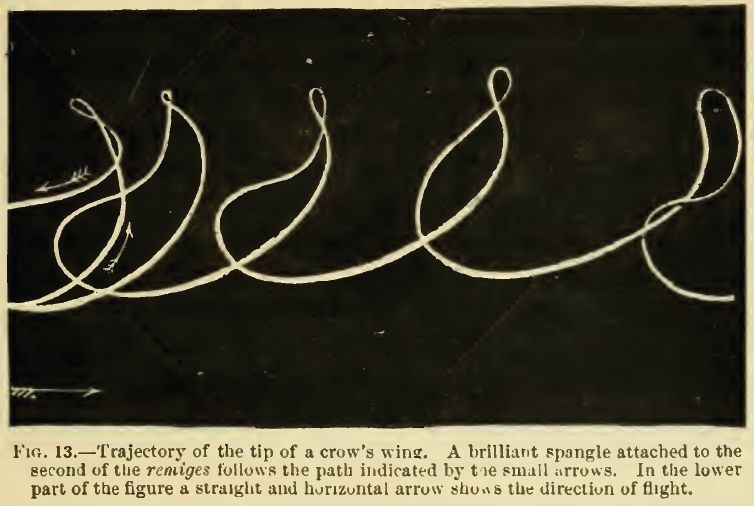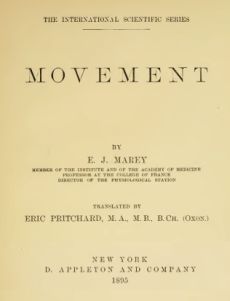Movement
Etienne-Jules Marey and Eric Pritchard (tr.)
Marey, Etienne-Jules; Eric Pritchard (tr.);
Movement
D. Appleton London, 1895, 323 pages fulltext
topics: | photography | design | motion |
a pioneering work from the close of the 19th century. along with Edward Muybridge (famed for his photographs of a horse's gallop), Marey was clearly fascinated by the possibilities of spatial motion measurement using time-lapse photography. In this amazing work, he lists "chronophotography" along with a number of other methods devised by him for capturing the essence of animal movements.
it appears that Marey is the first to note that in human running, there is a point where the body is suspended - i.e. it has no contact with the ground. It is this that distinguishes running from walking, a distinction much enforced in "walking" races today.
Excerpts
from Translator's Note by Pritchard
Instantaneous photography, especially that branch of it known as Chronophotography, has already won for itself a recognized position among the methods of scientific research, and in the near future it is probable that it will be even more generally appreciated. Marey and Muybridge must undoubtedly be regarded as the two pioneers of the method ; the works of the latter, written in English and published in America, are within the reach of all who can read the English language ; on the other hand, the works of Marey are for the most part inaccessible to those who are unfamiliar with French...
The idea of "timeline"
Marey is also a careful graphic designer, observing that "Language is as slow and obscure a method of expressing the duration and sequence of events as the graphic method is lucid and easy to understand." Today, timelines are ubiquitous as graphic renderings of events, but here we can see the idea evolving in its earliest stages.A diagram will [show] by a glance that the event A commences at 2 o'clock and finishes at 10 o'clock (its total duration is, therefore, 8 hours) ; that B, commencing at 6 and ending at 11 o'clock, has lasted 5 hours; and that C, commencing at 5 o'clock and ending at a 1/4 past 8, has only extended over a period of 3 1/4 hours. Language is as slow and obscure a method of expressing the duration and sequence of events as the graphic method is lucid and easy to understand. The earliest usage of the word "time line" cited in OED is from 1907: J. W. Adamson Practical of Instr. (1907) ii. iv. 275: A time line for English history.. can be made with great advantage when the class is taking its first connected course in English history.
Walking vs Running
Marey may be among the first observers to note the difference between walking and running. Marey devised a special contact-measuring shoe in order to obtain accurate measurements.Shoe for indicating when a man's foot comes in contact with the ground; a transmitting tube effects a communication between the air chamber and the chronographic tambour. Pneumatic tubes attached to the sole drive two needles that inscribe a paper wrapped over a smoothly rotating cylinder. The cylinder is called a "chronographic tambour". The "walker", with the pneumatic tubes strapped below his knee, would carry the chronographic apparatus with him. (But would the needle not vibrate while "running at great speed"?)
Chronographic record of the periods of contact of the feet of a man executing various paces. 1: Walking on level ground. 2. Walking upstairs 3. Running 4. Faster run. [For the runner], the periods of contact are short, and separated from one another by intervals during which neither foot is in contact with the ground — a period of suspension. [When] running at greater speed, the periods of contact are shorter and the intervals longer. p.8 Marey also devised a similar contact-recording "shoe" for horses, and reports their hoof contacts while ambling, walking, an trotting.
Ch. 2: Chronophotography (Time-Lapse photography)
The term chronophotography was coined around 1895, and had a short vogue in
the 1890s; OED has only two citations from 1895 and 1899.
1895 Pall Mall Gaz. 13 Nov. 4/1
The various kinds of apparatus required for the difficult
operations of ‘chronophotography’.
By 1926, we find the term "Time-lapse photography" coming into use.
1926 H. Green in Trans. Soc. Motion Picture & Television Engineers
No. 26. 147
(title) Apparatus for time lapse motion picture photography.
Wingbeat of a crow
Here is Marey, following a crow's wingtip:
The gait of a gecko
motion of a gecko as it walks across a glass plate. links: * http://classes.design.ucla.edu/Winter07/24/projects/cropper/Marey/ * wiki biography : Étienne-Jules Marey
Send your jottings to Book Excerptise
to contribute some excerpts from your favourite book to
book
excerptise. send us a plain text file with
page-numbered extracts from your favourite book. You can preface your
extracts with a short review.
email to (bookexcerptise [at] gmail [dot] com).
bookexcerptise is maintained by a small group of editors. comments are always welcome at bookexcerptise [at] gmail. This article last updated on : 2014 Mar 01
